Any discussion of sharpening woodworking tools is likely to generate plenty of disagreement among woodworkers. This is partly because it is difficult to comprehend exactly what is happening at the microscopic level as hard steel meets abrasive particles, but also because there is a wide variety effective tools and methods for achieving sharp edges.
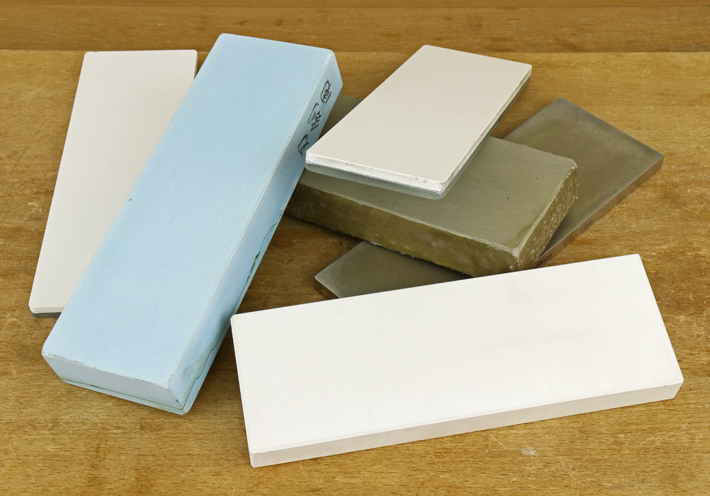
This can easily confuse the developing woodworker who wants to knowledgeably assemble a kit of sharpening tools. Let’s make matters clear by first looking at what it means for a blade to sharp, then considering several practical approaches for getting it sharp.
What makes a blade sharp?
A sharp edge is basically the meeting of two faces of very finely surfaced steel at a narrow acute angle. For plane blades, chisels and most other woodworking tools, the first requirements for sharpening a new tool are to flatten and polish the back. This makes it available to accurately meet the opposite (bevel) face of the tool to create the sharp edge.
A high quality tool will come from the factory with a back that is very nearly flat, requiring only modest refinement and then polishing to an extremely smooth finish. On the other hand, one of the prices paid for a cheap tool will be a lot of time and frustration in just these first steps. Once flattened and polished, the back of the blade should require only minimal attention for the life of the tool.
The opposite side of the tool has a bevel, generally with two parts. The primary bevel is typically formed at a 25-27-degree angle to the back, while the secondary bevel is usually 3-7-degree steeper. Specific angles are based on the use of the blade and the characteristics of the steel.
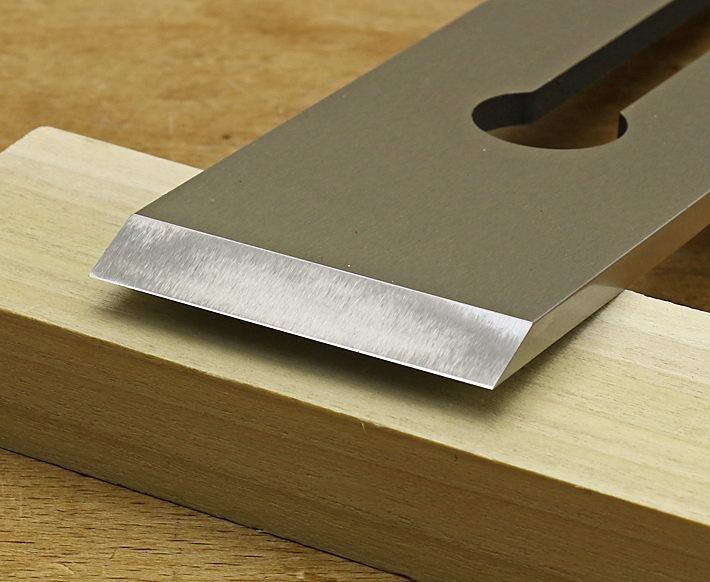
The secondary bevel is much narrower than the primary bevel. It is visible above as a very narrow, shiny, polished strip near the cutting edge of the blade. It is much more refined than the primary bevel by honing and polishing because this narrow surface is what meets the back surface of the blade, which also has been polished. It is the meeting of these two highly refined surfaces that constitutes a sharp edge.
For most hand plane blades, an additional important property of the cutting edge is a very shallow curvature across the width, known as camber. This allows the plane to produce a smooth, uninterrupted surface on the wood.
How to get it sharp
A set of sharpening stones in the following approximate grit sizes will cover the full range of work:
- Very coarse 200-300
- Coarse 1,000-1,200
- Intermediate 3,000-5,000
- Fine polishing 8,000-16,000
The very coarse stone removes steel quickly for rough shaping of the primary bevel and for initial flattening of the back of the blade. The coarse stone then improves these surfaces. For the back of the blade, flattening and polishing then proceed through the intermediate and fine stones.
The intermediate stone can be used to start the secondary bevel, which is then worked on the finest stone to produce the final keen edge. When it comes time to sharpen a mildly dulled edge, the secondary bevel can usually be reworked on the intermediate stone or sometimes the coarse stone, and again progressed through to completion on the fine stone.
All of this can be done with several effective types of sharpening tools:
- Waterstones, aluminum oxide or ceramic
- Diamond stones
- Sandpaper of various grits adhered to thick, flat glass (float glass)
- Oil stones
Waterstones are the most popular option. The finest of these can produce magnificent edges. Norton and Bester are examples of good, modestly priced stones. Shapton, Sigma, Naniwa and others make higher end stones. Ceramic stones generally cut faster than aluminum oxide stones and are more resistant to wear, but many factors affect a stone’s performance and any stone should be evaluated on its entire merit.
Diamond stones are a great option, especially for very coarse and coarse stones. The diamond abrasive is the fastest cutting of all and is extremely durable. Further, the surface of these stones remains permanently flat.
An excellent, very practical set of sharpening tools would be very coarse and coarse diamond stones along with intermediate and fine waterstones, as shown below. The latter two are often economically available combined as a two-sided stone, such as an Ohishi 3,000/10,000 stone. DMT DiaSharp and Atoma are outstanding diamond stones.
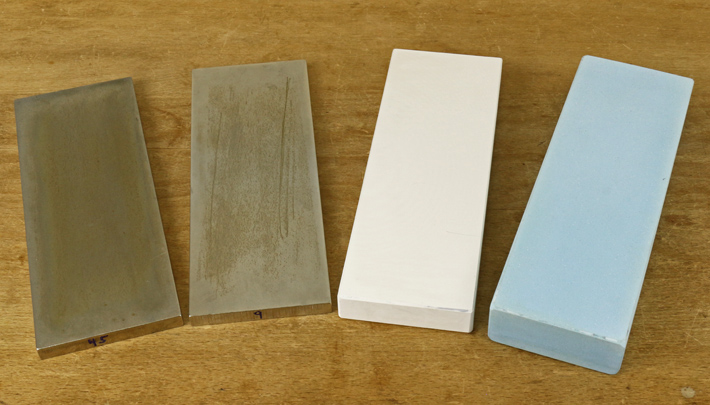
A different approach, the sandpaper method, is favored by many woodworkers who enjoy its non-fussy simplicity and speed. Yet another option, traditional oil stones, artificial for the coarsest grits and natural Arkansas for the intermediate and fine grits, have the advantage of great durability though they do not generally cut as fast or as finely as the best waterstones.
Other stuff
You’ll need some way to flatten stones (except diamond stones) as the surfaces get dished from wear. An inexpensive method is to use medium-grit sandpaper adhered to float glass. More convenient though considerably more expensive is a dedicated diamond stone, the Cadillac of which is DMT’s 120-grit DiaFlat Lapping Plate.
A honing guide is handy, especially as you are learning to sharpen. It allows you to keep the blade at a consistent angle to the stone and to repeat this angle in successive sharpenings. The Eclipse style guide is effective and inexpensive while the Veritas guide is more sophisticated and versatile.
What about a power grinder? An electric grinding wheel can quickly form the primary bevel, saving time and effort. This is something to consider as your commitment to the craft increases. Dry-wheel, high-speed grinders are fast and less expensive but care must be taken to avoid overheating the steel. Water-cooled grinders such as the high-end Tormek, shown here, operate at slower speeds and offer more control.
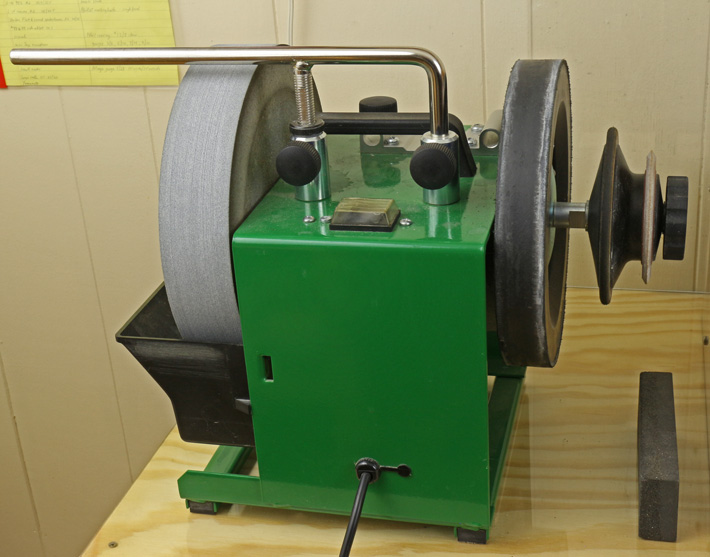
Some woodworkers prefer to add a final further refinement to an edge that has been sharpened on stones by stropping it on leather that has been charged with very fine abrasive paste. Diamond paste, available in extremely fine grits, is particularly effective. This is an additional step that you may want to consider later, as your methods become more refined.
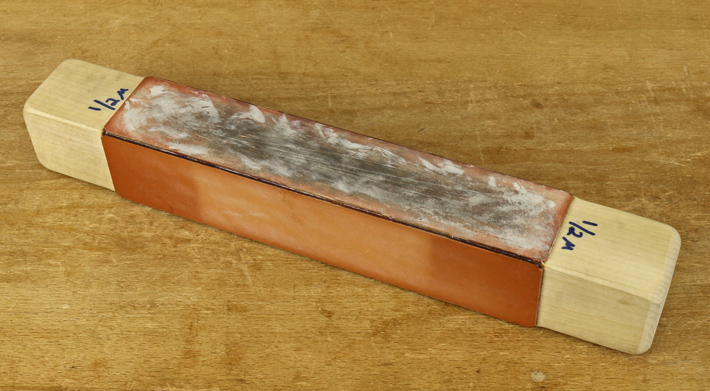
Finally, because sharpening is so essential to woodworking, consider having a dedicated place for it in your shop that is always ready for use and will house the paraphernalia and mess of the process.
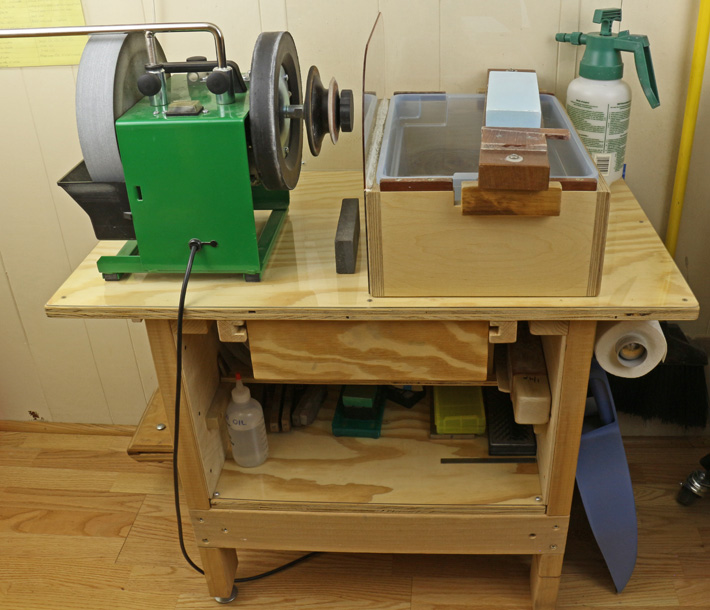

Share tips, start a discussion or ask one of our experts or other students a question.
No Responses to “Tools to Get Started in Woodworking: Sharpening Tools”